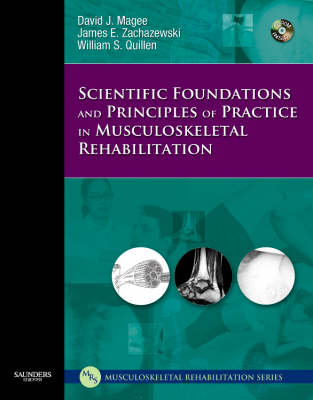
Scientific Foundations and Principles of Practice in Musculoskeletal Rehabilitation
W B Saunders Co Ltd (Verlag)
978-1-4160-0250-5 (ISBN)
Musculoskeletal Rehabilitation, Volume 2: Scientific Foundations and Principles of Practice provides a thorough review of the basic science information concerning the tissues of the musculoskeletal system impacted by injury or disease, as well as the guiding principles upon which rehabilitation interventions are based. This volume divides information into two sections: scientific foundations and principles of intervention, providing readers with a guiding set of clinical foundations and principles upon which they can easily develop treatment interventions for specific impairments and functional limitations.
Clinical application case studies help readers apply what they learn in the classroom to real life situations.
Evidence-based content uses over 5,000 references to support the basic science information principles for rehabilitation interventions and provide the best evidence and physiological reasoning for treatment.
Over 180 tables and 275 text boxes highlight key points within the text for better understanding.
Expert editors David Magee, PhD, PT, James Zachazewski, DPT, SCS, ATC, Sandy Quillen, PT, PhD, SCS, FACSM and over 70 contributors provide authoritative guidance on the foundations and principles of musculoskeletal rehabilitation practice.
SECTION I. SCIENTIFIC FOUNDATIONS
1.Injury, Inflammation, and Repair: Tissue Mechanics, the Healing Process, and Their Impact on the Musculoskeletal System
2.Ligament Injuries: Pathophysiology, Healing, and Treatment Considerations
3.Tendon Pathology and Injuries: Pathophysiology, Healing and Treatment Considerations
4.Adaptability of Skeletal Muscle: Response to Increased and Decreased Use
5.Skeletal Muscle: Deformation, Injury and Repair, and Treatment Considerations
6.Bone Biology and Mechanics
7.Cartilage of Human Joints and Related Structures
8.Peripheral Nerve: Structure, Function, and Physiology
9.Articular Neurophysiology and Sensorimotor Control
10.Pain: Perception and Mechanisms
11.Physiological Basis of Physical Agents
12.Pharmacology and Its Impact on the Rehabilitation Process
13.Effects of Aging-Growth Changes and Lifespan Concerns (0-40)
14.Effects of Aging: Growth Changes and Lifespan Concerns Ages 40+
SECTION II. PRINCIPLES OF PRACTICE
15.Rehabilitation Program Development: Clinical Decision Making, Prioritization, and Program Integration
16.Clinician's Roles in Health Promotion, Wellness, and Physical Fitness
17.Physiological Principles of Conditioning for the Injured and Disabled
18.Principles of Neuromuscular Control for Injury Prevention and Rehabilitation
19.Principles of Stabilization and Training
20.Integration of the Cardiovascular System in Assessment and Interventions in Musculoskeletal Rehabilitation
21.Physiological Principles of Resistance Training And Functional Integration For The Injured and Disabled
22.Psychology of the Injured Patient
23.Integration of Stresses and their Relationship To The Kinetic Chain
24.Arthrokinematics and Mobilization of Musculoskeletal Tissue: The Principles
25.Range of Motion and Flexibility
26.The Utility of Orthopaedic Clinical Tests for Diagnosis
27.Imaging Joints and Musculoskeletal Tissue: Pathoanatomic Considerations
28.Fracture Management
29. Functional Testing and Return to Activity
| Erscheint lt. Verlag | 5.4.2007 |
|---|---|
| Verlagsort | London |
| Sprache | englisch |
| Maße | 216 x 276 mm |
| Gewicht | 2040 g |
| Themenwelt | Medizin / Pharmazie ► Medizinische Fachgebiete ► Orthopädie |
| Medizin / Pharmazie ► Physiotherapie / Ergotherapie ► Rehabilitation | |
| ISBN-10 | 1-4160-0250-2 / 1416002502 |
| ISBN-13 | 978-1-4160-0250-5 / 9781416002505 |
| Zustand | Neuware |
| Haben Sie eine Frage zum Produkt? |
aus dem Bereich


